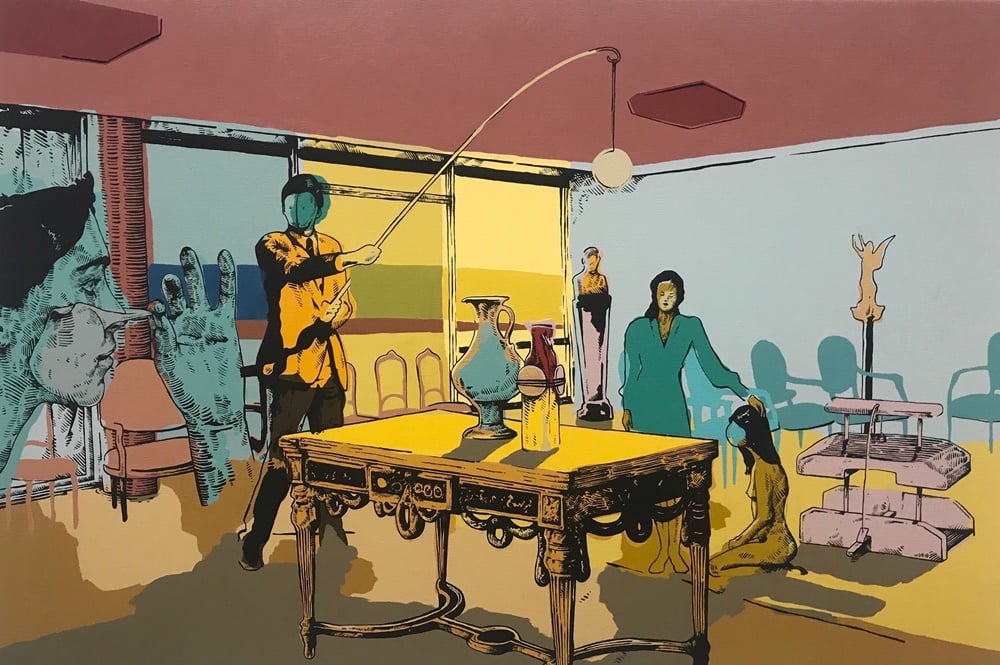
Among art fairs, VOLTA‘s format remains unique, in that all its participating galleries are asked to present a solo booth. It’s a simple conceit, but one that allows for a sense of depth and context, and a level of visual focus that cuts against the visual overload that can make the fairs so fatiguing.
“Much thought goes into placing the galleries in such a way that meaningful dialogues between different artists, especially in this solo context, create an even deeper understanding and appreciation of the variety of artistic positions presented,” said Amanda Coulson, artistic director of the fair.
This year marks VOLTA’s eleventh in New York City and its fourth at Pier 90, where the proximity to Armory has boosted attendance considerably. (For the curious, the fair’s name comes from the fact that it got its start as a satellite fair in Basel, Switzerland, where it was housed in a former electric plant there.)
There’s plenty to see. Don’t miss, for instance, the latest curated group show at the center of the fair. This year’s edition was organized by Mickalene Thomas and Racquel Chevremont, titled “The Aesthetics of Matter.” It focuses on collage by several rising stars.
Below, we break out a few of the standout solo projects of VOLTA New York 2018.
Alan Fontes at Galeria Emma Thomas, São Paulo, Brazil
Alan Fontes “The House” at Galeria Emma Thomas of Sao Paulo, Brazil. Photo by Eileen Kinsella
Houses, or the remnants of their structures in the wake of disaster, are a recurring motif in Brazilian artist Alan Fontes‘s work. The interior of his solo installation booth at Galeria Emma Thomas for VOLTA, titled “The House” is centered on the idea of a three-dimensional painting, says director Camila Neubarth. It conjures up associations of an owner or occupant wandering through their home in the dazed aftermath of catastrophe.
Detail of Alan Fontes solo presentation “The House” at Galeria Emma Thomas, São Paulo, Brazil.
Photo by Eileen Kinsella
Visitors navigate detritus including scattered floor tiles, picture frames, suitcases, and bottles, along with destroyed furniture and even a piano, all cast in a dull shade of volcanic ash-gray. The paintings that hang on the walls of the space depict eerie small-scale houses, islands in a sea of black paint as well as larger depictions of houses sliced in half or with entire sections missing, with piles of personal belongings still visible inside, evoking post-disaster news imagery.
Tommy Hartung at C24, New York
Tommy Hartung’s installation at C24 Gallery, titled R.U.R. (Rossum’s Universal Robots), is based on Karel Čapek’s 1920 science fiction play where the term “robot” was first used. The play explores the uncertainties raised by the speed of technological progress and the dehumanization that occurs with the robotization of human interactions. In Hartung’s adaptation, the original work is re-written through photographs, costumes, and videos, posing the question of why people want robots to look human.
Tommy Hartung, R.U.R. ACT ONE: THE vIEWER [still] (2018). Image courtesy C24.
William Buchina at Slag Gallery, Brooklyn, New York
William Buchina, Common Structures, Simple Mechanics & Varying Degrees of Affection #5 (2017). Image courtesy SLAG Gallery.
William Buchina‘s “rephrasing” and reutilization of primary source material are what Slag Gallery gallery director Irina Protopopescu describe as part of “a crusade unpack his own creative process.”
The result is an intriguing series of paintings that invite careful study, albeit without delivering a clear or linear narrative. But that’s part of the fun.
The process of making the works is central to the story-line, says Protopopescu. “In making them I imagine a lost ritual… random and unrelated elements take over,” Buchina said in a statement.